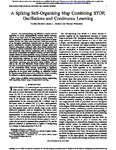A Spiking Self-Organising Map Combining STDP, Oscillations and Continuous Learning
| dc.contributor.author | Rumbell, T | |
| dc.contributor.author | denham, susan | |
| dc.contributor.author | Wennekers, Thomas | |
| dc.date.accessioned | 2016-07-28T19:32:42Z | |
| dc.date.available | 2016-07-28T19:32:42Z | |
| dc.date.issued | 2014-05-01 | |
| dc.identifier.issn | 2162-237X | |
| dc.identifier.issn | 2162-2388 | |
| dc.identifier.uri | http://hdl.handle.net/10026.1/5136 | |
| dc.description | Open Access article EPSRC EP/C010841/1, EP/J004561/1 | |
| dc.description.abstract |
The self-organizing map (SOM) is a neural network algorithm to create topographically ordered spatial representations of an input data set using unsupervised learning. The SOM algorithm is inspired by the feature maps found in mammalian cortices but lacks some important functional properties of its biological equivalents. Neurons have no direct access to global information, transmit information through spikes and may be using phasic coding of spike times within synchronized oscillations, receive continuous input from the environment, do not necessarily alter network properties such as learning rate and lateral connectivity throughout training, and learn through relative timing of action potentials across a synaptic connection. In this paper, a network of integrate-and-fire neurons is presented that incorporates solutions to each of these issues through the neuron model and network structure. Results of the simulated experiments assessing map formation using artificial data as well as the Iris and Wisconsin Breast Cancer datasets show that this novel implementation maintains fundamental properties of the conventional SOM, thereby representing a significant step toward further understanding of the self-organizational properties of the brain while providing an additional method for implementing SOMs that can be utilized for future modeling in software or special purpose spiking neuron hardware. | |
| dc.format.extent | 894-907 | |
| dc.format.medium | ||
| dc.language | eng | |
| dc.language.iso | en | |
| dc.publisher | Institute of Electrical and Electronics Engineers (IEEE) | |
| dc.subject | Artificial neural networks | |
| dc.subject | neural engineering | |
| dc.subject | self-organizing feature maps | |
| dc.subject | unsupervised learning | |
| dc.title | A Spiking Self-Organising Map Combining STDP, Oscillations and Continuous Learning | |
| dc.type | journal-article | |
| dc.type | Article | |
| plymouth.author-url | https://www.webofscience.com/api/gateway?GWVersion=2&SrcApp=PARTNER_APP&SrcAuth=LinksAMR&KeyUT=WOS:000334738400004&DestLinkType=FullRecord&DestApp=ALL_WOS&UsrCustomerID=11bb513d99f797142bcfeffcc58ea008 | |
| plymouth.issue | 5 | |
| plymouth.volume | 25 | |
| plymouth.publication-status | Published | |
| plymouth.journal | IEEE Transactions on neural networks and learning systems | |
| dc.identifier.doi | 10.1109/TNNLS.2013.2283140 | |
| plymouth.organisational-group | /Plymouth | |
| plymouth.organisational-group | /Plymouth/Admin Group - REF | |
| plymouth.organisational-group | /Plymouth/Admin Group - REF/REF Admin Group - FoSE | |
| plymouth.organisational-group | /Plymouth/Faculty of Science and Engineering | |
| plymouth.organisational-group | /Plymouth/Faculty of Science and Engineering/School of Engineering, Computing and Mathematics | |
| plymouth.organisational-group | /Plymouth/REF 2021 Researchers by UoA | |
| plymouth.organisational-group | /Plymouth/REF 2021 Researchers by UoA/UoA04 Psychology, Psychiatry and Neuroscience | |
| plymouth.organisational-group | /Plymouth/REF 2021 Researchers by UoA/UoA11 Computer Science and Informatics | |
| plymouth.organisational-group | /Plymouth/Research Groups | |
| plymouth.organisational-group | /Plymouth/Research Groups/Centre for Brain, Cognition and Behaviour (CBCB) | |
| plymouth.organisational-group | /Plymouth/Research Groups/Centre for Brain, Cognition and Behaviour (CBCB)/Brain | |
| plymouth.organisational-group | /Plymouth/Users by role | |
| plymouth.organisational-group | /Plymouth/Users by role/Academics | |
| dc.publisher.place | United States | |
| dc.identifier.eissn | 2162-2388 | |
| dc.rights.embargoperiod | No embargo | |
| rioxxterms.funder | EPSRC | |
| rioxxterms.identifier.project | BABEL | |
| rioxxterms.versionofrecord | 10.1109/TNNLS.2013.2283140 | |
| rioxxterms.licenseref.uri | http://www.rioxx.net/licenses/all-rights-reserved | |
| rioxxterms.type | Journal Article/Review | |
| plymouth.funder | BABEL::EPSRC |


